MBA622 Comprehensive Health Strategies: Aged Care Analysis
VerifiedAdded on 2023/06/15
|13
|3217
|499
Report
AI Summary
This report provides a comprehensive analysis of the aged care industry within the Australian healthcare sector, examining its growth and impact over the past decade. It explores various influencing factors such as competition, emerging care models, and government involvement, including subsidies. The analysis delves into market trends, opportunities, and setbacks, highlighting ethical issues surrounding aged care provision. Key aspects discussed include the user-pays system, the role of private and public healthcare, and the influence of physical, environmental, and social factors on aged care delivery. The report also addresses ethical considerations, such as patient-physician relationships, Hippocratic Oath adherence, and the importance of equitable and non-negligent care, referencing the Belmont Report's principles of respect, beneficence, and justice. The report concludes by emphasizing the need for continued improvement in aged care to ensure the well-being of the elderly population.
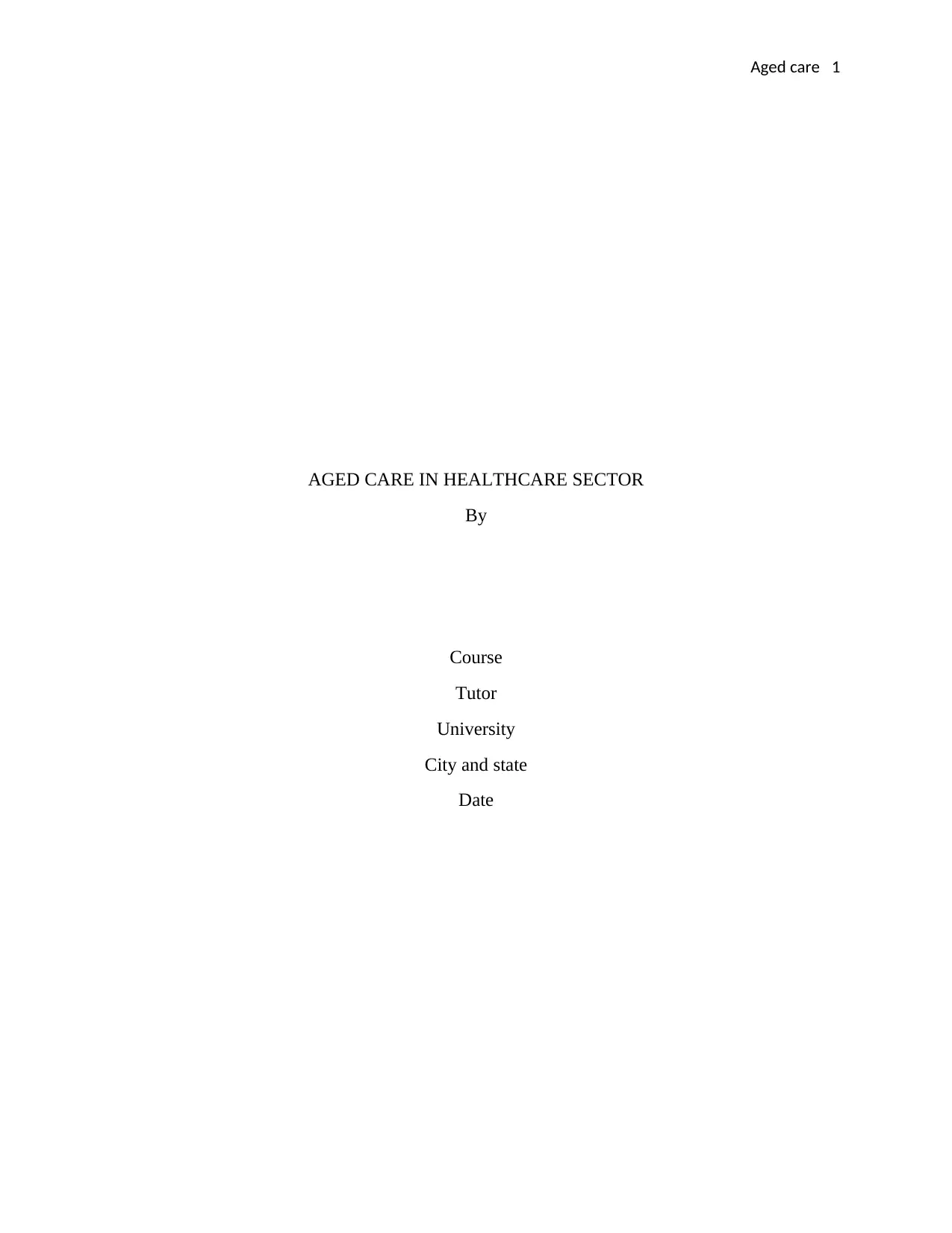
Aged care 1
AGED CARE IN HEALTHCARE SECTOR
By
Course
Tutor
University
City and state
Date
AGED CARE IN HEALTHCARE SECTOR
By
Course
Tutor
University
City and state
Date
Paraphrase This Document
Need a fresh take? Get an instant paraphrase of this document with our AI Paraphraser
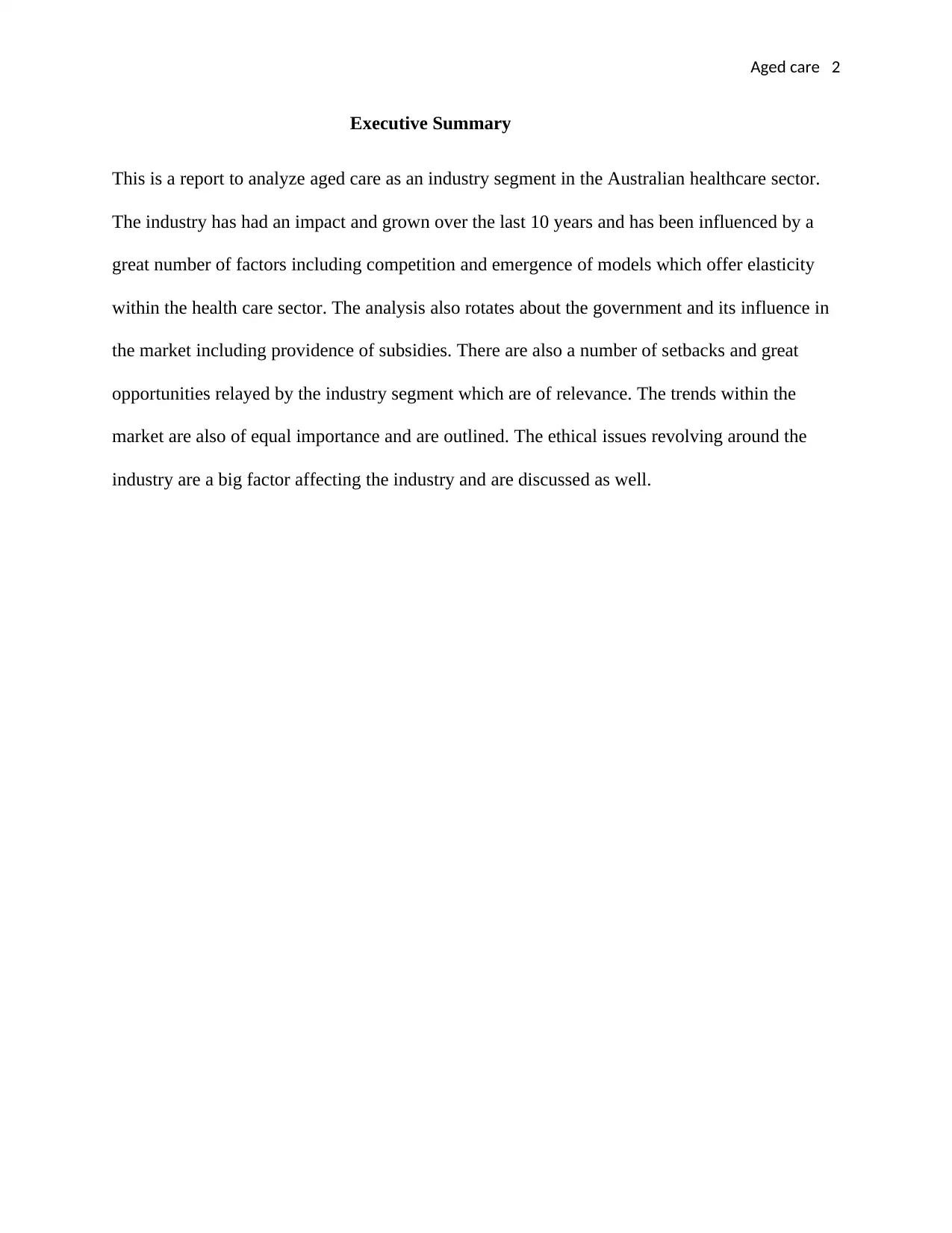
Aged care 2
Executive Summary
This is a report to analyze aged care as an industry segment in the Australian healthcare sector.
The industry has had an impact and grown over the last 10 years and has been influenced by a
great number of factors including competition and emergence of models which offer elasticity
within the health care sector. The analysis also rotates about the government and its influence in
the market including providence of subsidies. There are also a number of setbacks and great
opportunities relayed by the industry segment which are of relevance. The trends within the
market are also of equal importance and are outlined. The ethical issues revolving around the
industry are a big factor affecting the industry and are discussed as well.
Executive Summary
This is a report to analyze aged care as an industry segment in the Australian healthcare sector.
The industry has had an impact and grown over the last 10 years and has been influenced by a
great number of factors including competition and emergence of models which offer elasticity
within the health care sector. The analysis also rotates about the government and its influence in
the market including providence of subsidies. There are also a number of setbacks and great
opportunities relayed by the industry segment which are of relevance. The trends within the
market are also of equal importance and are outlined. The ethical issues revolving around the
industry are a big factor affecting the industry and are discussed as well.
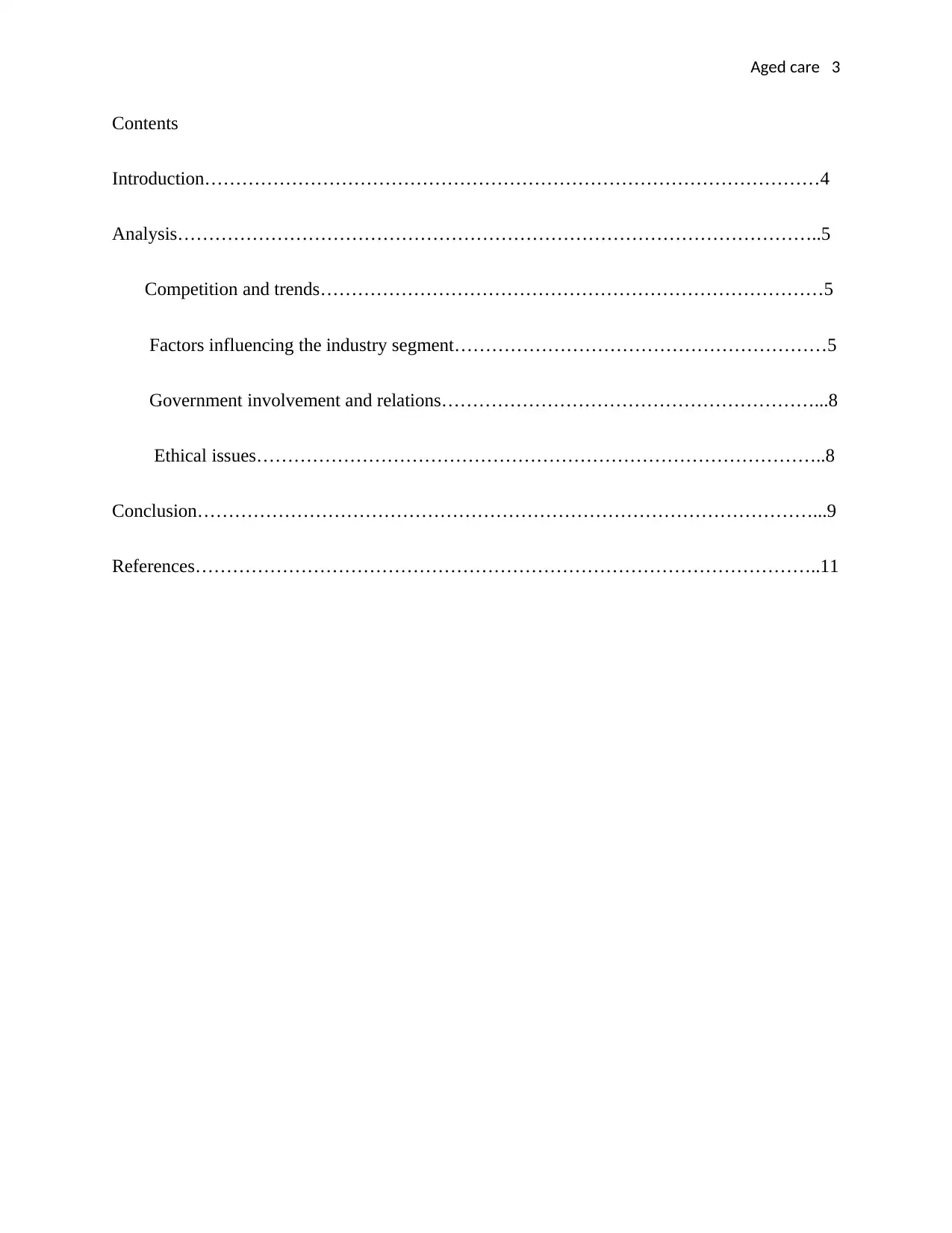
Aged care 3
Contents
Introduction………………………………………………………………………………………4
Analysis…………………………………………………………………………………………..5
Competition and trends………………………………………………………………………5
Factors influencing the industry segment……………………………………………………5
Government involvement and relations……………………………………………………...8
Ethical issues………………………………………………………………………………..8
Conclusion………………………………………………………………………………………...9
References………………………………………………………………………………………..11
Contents
Introduction………………………………………………………………………………………4
Analysis…………………………………………………………………………………………..5
Competition and trends………………………………………………………………………5
Factors influencing the industry segment……………………………………………………5
Government involvement and relations……………………………………………………...8
Ethical issues………………………………………………………………………………..8
Conclusion………………………………………………………………………………………...9
References………………………………………………………………………………………..11
⊘ This is a preview!⊘
Do you want full access?
Subscribe today to unlock all pages.

Trusted by 1+ million students worldwide
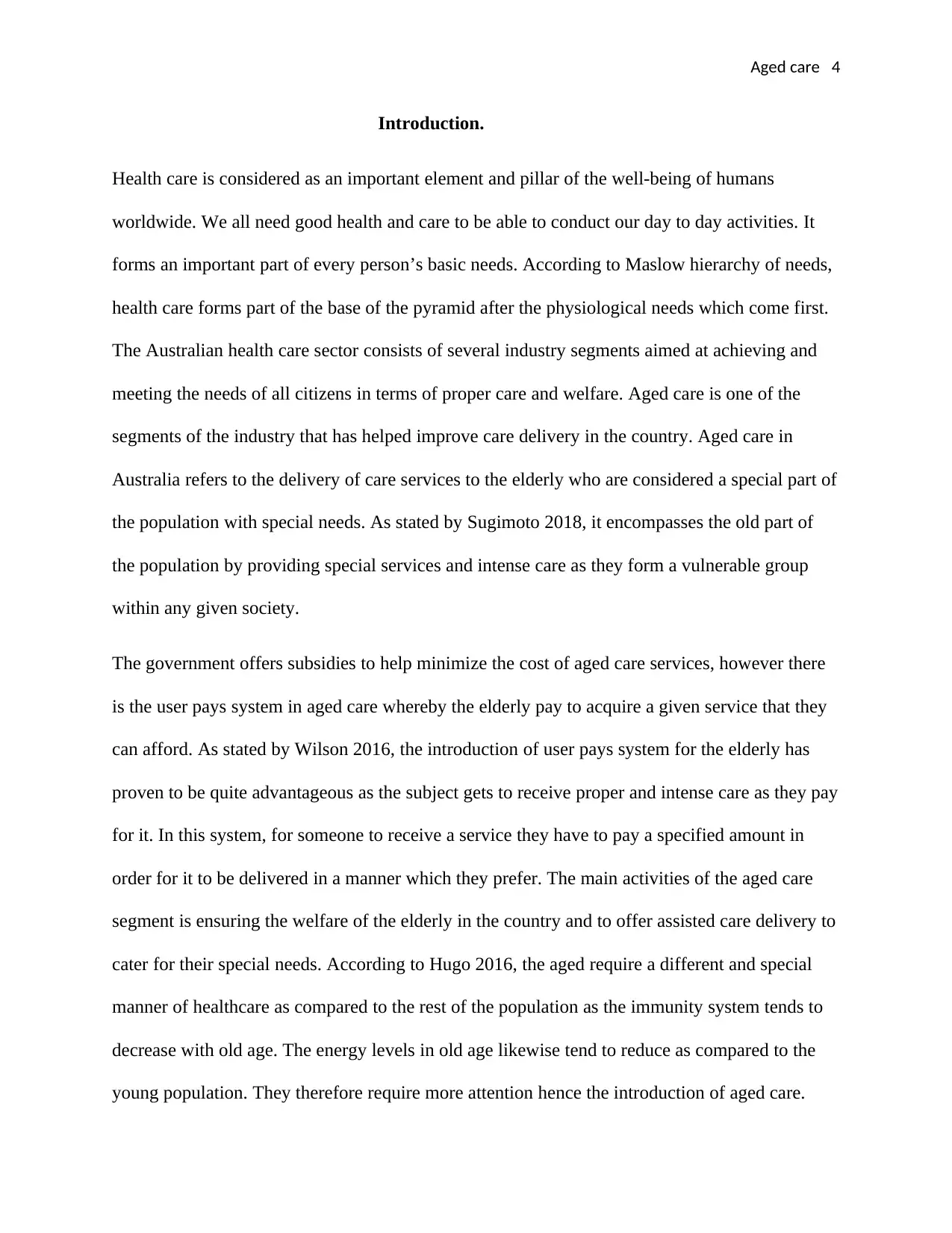
Aged care 4
Introduction.
Health care is considered as an important element and pillar of the well-being of humans
worldwide. We all need good health and care to be able to conduct our day to day activities. It
forms an important part of every person’s basic needs. According to Maslow hierarchy of needs,
health care forms part of the base of the pyramid after the physiological needs which come first.
The Australian health care sector consists of several industry segments aimed at achieving and
meeting the needs of all citizens in terms of proper care and welfare. Aged care is one of the
segments of the industry that has helped improve care delivery in the country. Aged care in
Australia refers to the delivery of care services to the elderly who are considered a special part of
the population with special needs. As stated by Sugimoto 2018, it encompasses the old part of
the population by providing special services and intense care as they form a vulnerable group
within any given society.
The government offers subsidies to help minimize the cost of aged care services, however there
is the user pays system in aged care whereby the elderly pay to acquire a given service that they
can afford. As stated by Wilson 2016, the introduction of user pays system for the elderly has
proven to be quite advantageous as the subject gets to receive proper and intense care as they pay
for it. In this system, for someone to receive a service they have to pay a specified amount in
order for it to be delivered in a manner which they prefer. The main activities of the aged care
segment is ensuring the welfare of the elderly in the country and to offer assisted care delivery to
cater for their special needs. According to Hugo 2016, the aged require a different and special
manner of healthcare as compared to the rest of the population as the immunity system tends to
decrease with old age. The energy levels in old age likewise tend to reduce as compared to the
young population. They therefore require more attention hence the introduction of aged care.
Introduction.
Health care is considered as an important element and pillar of the well-being of humans
worldwide. We all need good health and care to be able to conduct our day to day activities. It
forms an important part of every person’s basic needs. According to Maslow hierarchy of needs,
health care forms part of the base of the pyramid after the physiological needs which come first.
The Australian health care sector consists of several industry segments aimed at achieving and
meeting the needs of all citizens in terms of proper care and welfare. Aged care is one of the
segments of the industry that has helped improve care delivery in the country. Aged care in
Australia refers to the delivery of care services to the elderly who are considered a special part of
the population with special needs. As stated by Sugimoto 2018, it encompasses the old part of
the population by providing special services and intense care as they form a vulnerable group
within any given society.
The government offers subsidies to help minimize the cost of aged care services, however there
is the user pays system in aged care whereby the elderly pay to acquire a given service that they
can afford. As stated by Wilson 2016, the introduction of user pays system for the elderly has
proven to be quite advantageous as the subject gets to receive proper and intense care as they pay
for it. In this system, for someone to receive a service they have to pay a specified amount in
order for it to be delivered in a manner which they prefer. The main activities of the aged care
segment is ensuring the welfare of the elderly in the country and to offer assisted care delivery to
cater for their special needs. According to Hugo 2016, the aged require a different and special
manner of healthcare as compared to the rest of the population as the immunity system tends to
decrease with old age. The energy levels in old age likewise tend to reduce as compared to the
young population. They therefore require more attention hence the introduction of aged care.
Paraphrase This Document
Need a fresh take? Get an instant paraphrase of this document with our AI Paraphraser
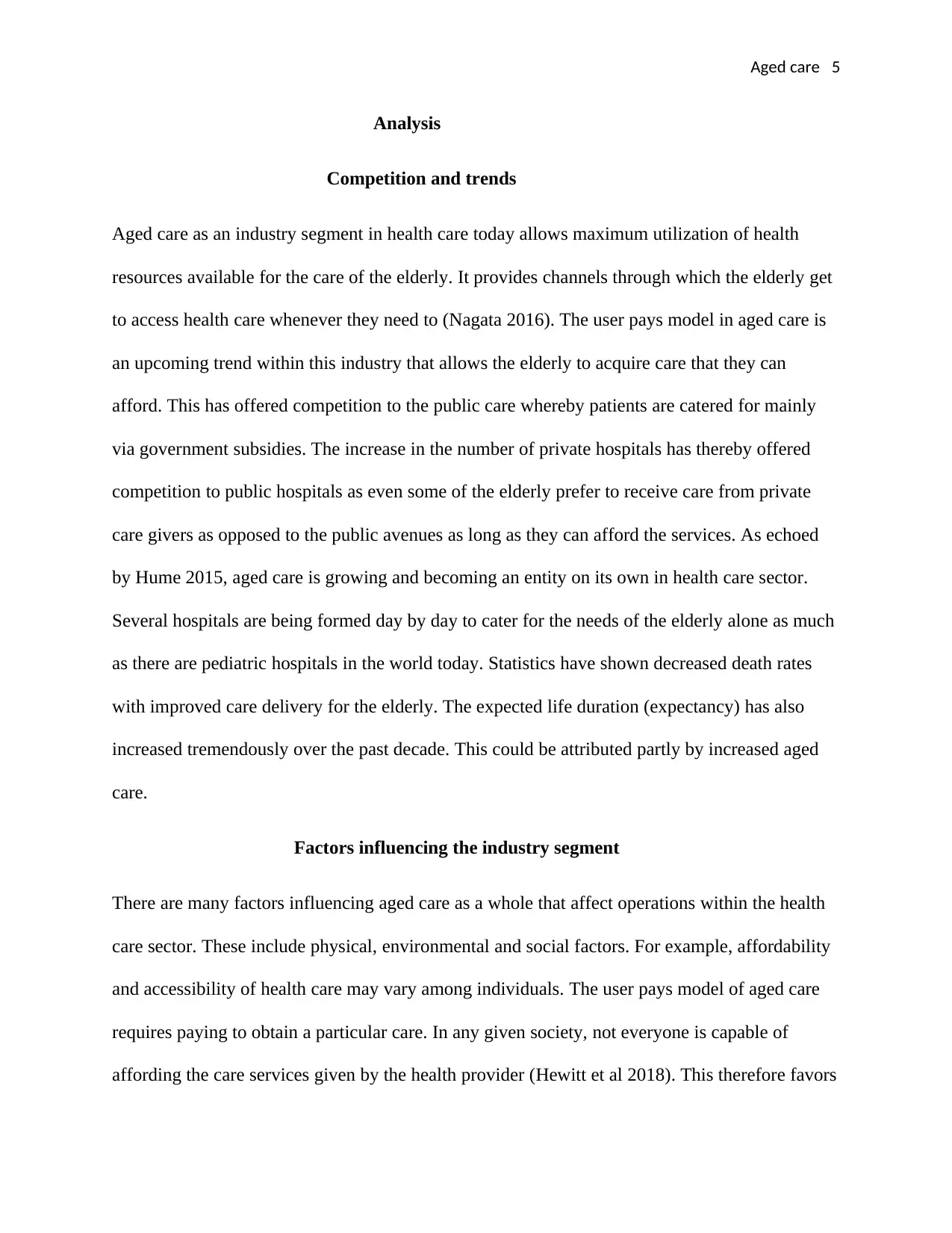
Aged care 5
Analysis
Competition and trends
Aged care as an industry segment in health care today allows maximum utilization of health
resources available for the care of the elderly. It provides channels through which the elderly get
to access health care whenever they need to (Nagata 2016). The user pays model in aged care is
an upcoming trend within this industry that allows the elderly to acquire care that they can
afford. This has offered competition to the public care whereby patients are catered for mainly
via government subsidies. The increase in the number of private hospitals has thereby offered
competition to public hospitals as even some of the elderly prefer to receive care from private
care givers as opposed to the public avenues as long as they can afford the services. As echoed
by Hume 2015, aged care is growing and becoming an entity on its own in health care sector.
Several hospitals are being formed day by day to cater for the needs of the elderly alone as much
as there are pediatric hospitals in the world today. Statistics have shown decreased death rates
with improved care delivery for the elderly. The expected life duration (expectancy) has also
increased tremendously over the past decade. This could be attributed partly by increased aged
care.
Factors influencing the industry segment
There are many factors influencing aged care as a whole that affect operations within the health
care sector. These include physical, environmental and social factors. For example, affordability
and accessibility of health care may vary among individuals. The user pays model of aged care
requires paying to obtain a particular care. In any given society, not everyone is capable of
affording the care services given by the health provider (Hewitt et al 2018). This therefore favors
Analysis
Competition and trends
Aged care as an industry segment in health care today allows maximum utilization of health
resources available for the care of the elderly. It provides channels through which the elderly get
to access health care whenever they need to (Nagata 2016). The user pays model in aged care is
an upcoming trend within this industry that allows the elderly to acquire care that they can
afford. This has offered competition to the public care whereby patients are catered for mainly
via government subsidies. The increase in the number of private hospitals has thereby offered
competition to public hospitals as even some of the elderly prefer to receive care from private
care givers as opposed to the public avenues as long as they can afford the services. As echoed
by Hume 2015, aged care is growing and becoming an entity on its own in health care sector.
Several hospitals are being formed day by day to cater for the needs of the elderly alone as much
as there are pediatric hospitals in the world today. Statistics have shown decreased death rates
with improved care delivery for the elderly. The expected life duration (expectancy) has also
increased tremendously over the past decade. This could be attributed partly by increased aged
care.
Factors influencing the industry segment
There are many factors influencing aged care as a whole that affect operations within the health
care sector. These include physical, environmental and social factors. For example, affordability
and accessibility of health care may vary among individuals. The user pays model of aged care
requires paying to obtain a particular care. In any given society, not everyone is capable of
affording the care services given by the health provider (Hewitt et al 2018). This therefore favors
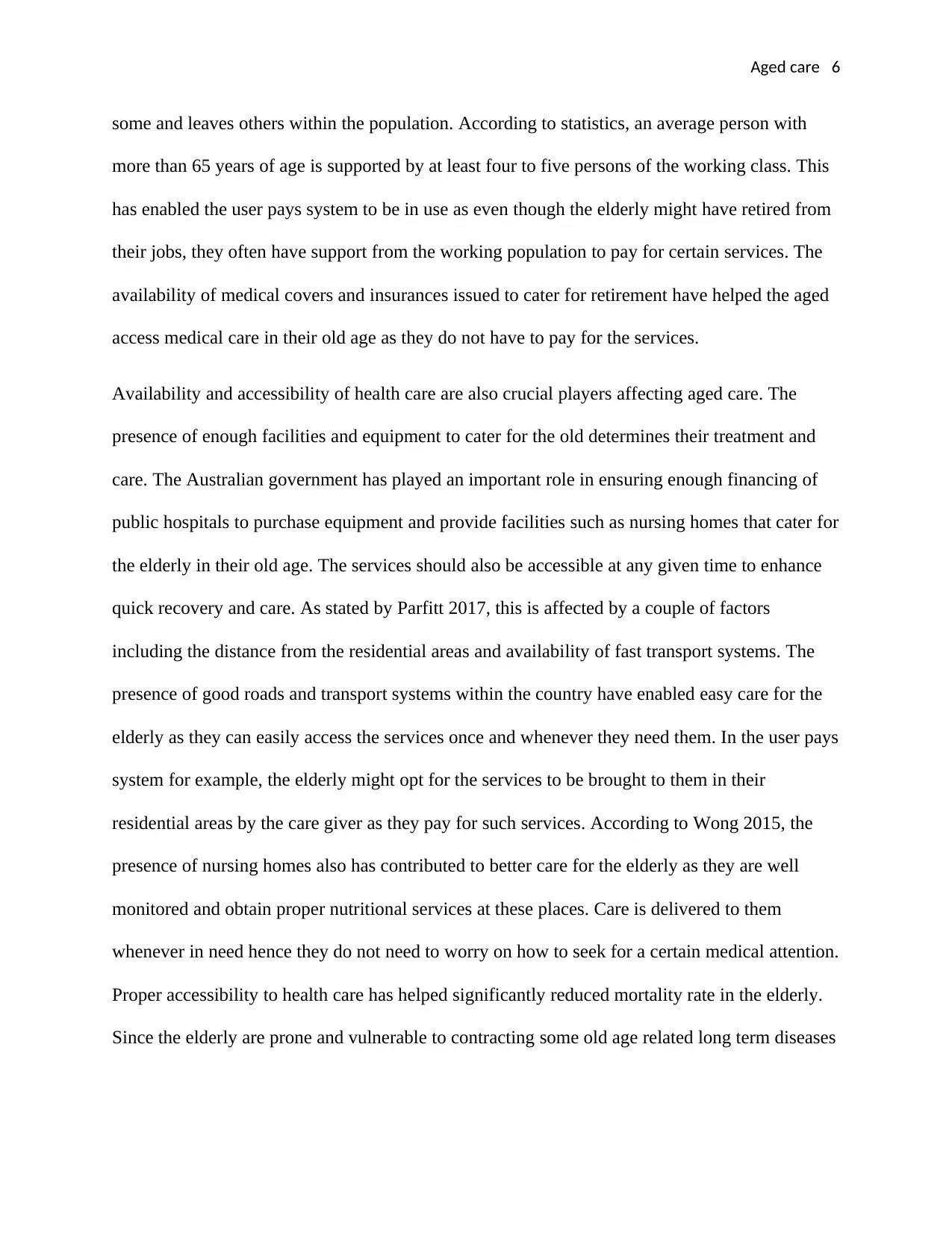
Aged care 6
some and leaves others within the population. According to statistics, an average person with
more than 65 years of age is supported by at least four to five persons of the working class. This
has enabled the user pays system to be in use as even though the elderly might have retired from
their jobs, they often have support from the working population to pay for certain services. The
availability of medical covers and insurances issued to cater for retirement have helped the aged
access medical care in their old age as they do not have to pay for the services.
Availability and accessibility of health care are also crucial players affecting aged care. The
presence of enough facilities and equipment to cater for the old determines their treatment and
care. The Australian government has played an important role in ensuring enough financing of
public hospitals to purchase equipment and provide facilities such as nursing homes that cater for
the elderly in their old age. The services should also be accessible at any given time to enhance
quick recovery and care. As stated by Parfitt 2017, this is affected by a couple of factors
including the distance from the residential areas and availability of fast transport systems. The
presence of good roads and transport systems within the country have enabled easy care for the
elderly as they can easily access the services once and whenever they need them. In the user pays
system for example, the elderly might opt for the services to be brought to them in their
residential areas by the care giver as they pay for such services. According to Wong 2015, the
presence of nursing homes also has contributed to better care for the elderly as they are well
monitored and obtain proper nutritional services at these places. Care is delivered to them
whenever in need hence they do not need to worry on how to seek for a certain medical attention.
Proper accessibility to health care has helped significantly reduced mortality rate in the elderly.
Since the elderly are prone and vulnerable to contracting some old age related long term diseases
some and leaves others within the population. According to statistics, an average person with
more than 65 years of age is supported by at least four to five persons of the working class. This
has enabled the user pays system to be in use as even though the elderly might have retired from
their jobs, they often have support from the working population to pay for certain services. The
availability of medical covers and insurances issued to cater for retirement have helped the aged
access medical care in their old age as they do not have to pay for the services.
Availability and accessibility of health care are also crucial players affecting aged care. The
presence of enough facilities and equipment to cater for the old determines their treatment and
care. The Australian government has played an important role in ensuring enough financing of
public hospitals to purchase equipment and provide facilities such as nursing homes that cater for
the elderly in their old age. The services should also be accessible at any given time to enhance
quick recovery and care. As stated by Parfitt 2017, this is affected by a couple of factors
including the distance from the residential areas and availability of fast transport systems. The
presence of good roads and transport systems within the country have enabled easy care for the
elderly as they can easily access the services once and whenever they need them. In the user pays
system for example, the elderly might opt for the services to be brought to them in their
residential areas by the care giver as they pay for such services. According to Wong 2015, the
presence of nursing homes also has contributed to better care for the elderly as they are well
monitored and obtain proper nutritional services at these places. Care is delivered to them
whenever in need hence they do not need to worry on how to seek for a certain medical attention.
Proper accessibility to health care has helped significantly reduced mortality rate in the elderly.
Since the elderly are prone and vulnerable to contracting some old age related long term diseases
⊘ This is a preview!⊘
Do you want full access?
Subscribe today to unlock all pages.

Trusted by 1+ million students worldwide
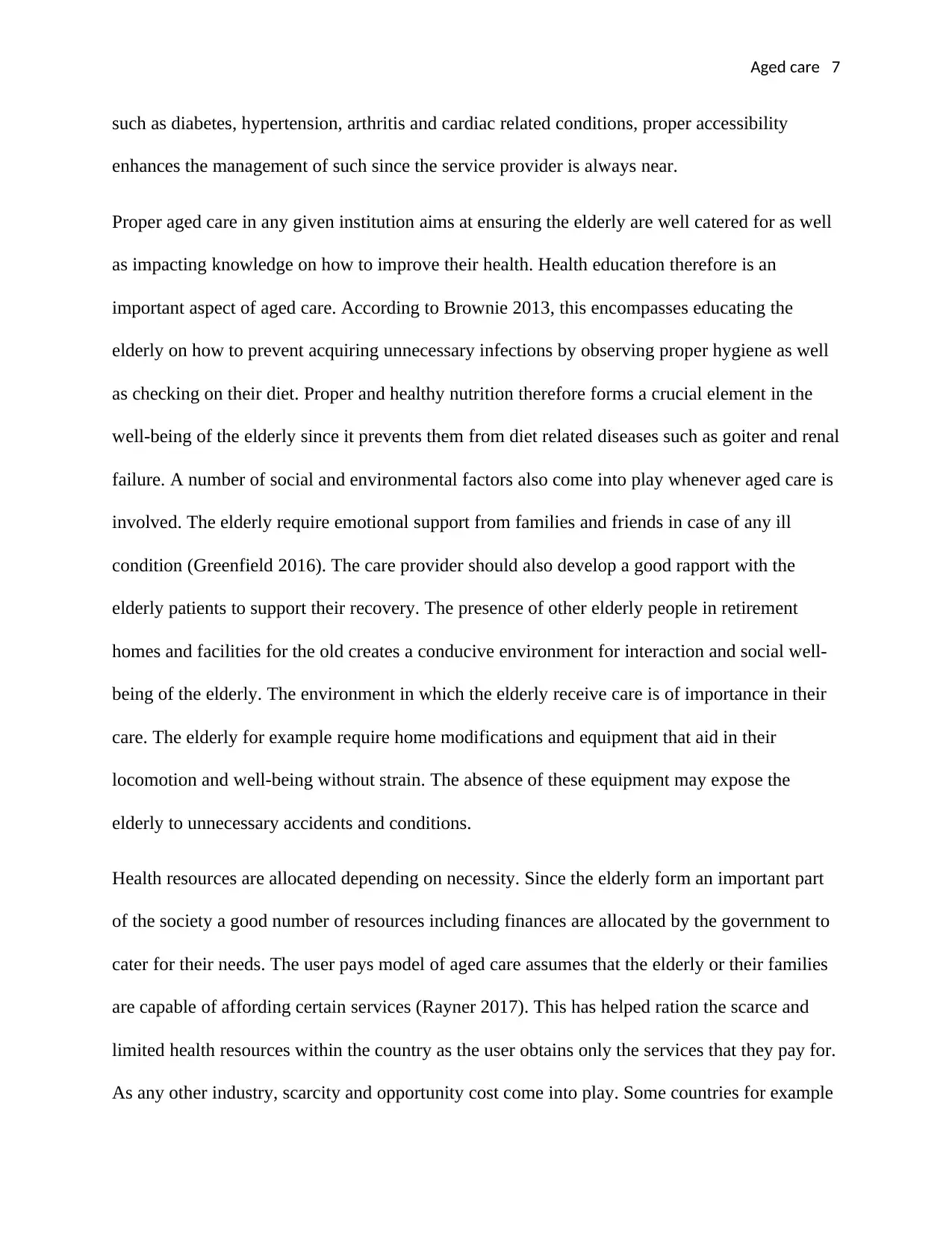
Aged care 7
such as diabetes, hypertension, arthritis and cardiac related conditions, proper accessibility
enhances the management of such since the service provider is always near.
Proper aged care in any given institution aims at ensuring the elderly are well catered for as well
as impacting knowledge on how to improve their health. Health education therefore is an
important aspect of aged care. According to Brownie 2013, this encompasses educating the
elderly on how to prevent acquiring unnecessary infections by observing proper hygiene as well
as checking on their diet. Proper and healthy nutrition therefore forms a crucial element in the
well-being of the elderly since it prevents them from diet related diseases such as goiter and renal
failure. A number of social and environmental factors also come into play whenever aged care is
involved. The elderly require emotional support from families and friends in case of any ill
condition (Greenfield 2016). The care provider should also develop a good rapport with the
elderly patients to support their recovery. The presence of other elderly people in retirement
homes and facilities for the old creates a conducive environment for interaction and social well-
being of the elderly. The environment in which the elderly receive care is of importance in their
care. The elderly for example require home modifications and equipment that aid in their
locomotion and well-being without strain. The absence of these equipment may expose the
elderly to unnecessary accidents and conditions.
Health resources are allocated depending on necessity. Since the elderly form an important part
of the society a good number of resources including finances are allocated by the government to
cater for their needs. The user pays model of aged care assumes that the elderly or their families
are capable of affording certain services (Rayner 2017). This has helped ration the scarce and
limited health resources within the country as the user obtains only the services that they pay for.
As any other industry, scarcity and opportunity cost come into play. Some countries for example
such as diabetes, hypertension, arthritis and cardiac related conditions, proper accessibility
enhances the management of such since the service provider is always near.
Proper aged care in any given institution aims at ensuring the elderly are well catered for as well
as impacting knowledge on how to improve their health. Health education therefore is an
important aspect of aged care. According to Brownie 2013, this encompasses educating the
elderly on how to prevent acquiring unnecessary infections by observing proper hygiene as well
as checking on their diet. Proper and healthy nutrition therefore forms a crucial element in the
well-being of the elderly since it prevents them from diet related diseases such as goiter and renal
failure. A number of social and environmental factors also come into play whenever aged care is
involved. The elderly require emotional support from families and friends in case of any ill
condition (Greenfield 2016). The care provider should also develop a good rapport with the
elderly patients to support their recovery. The presence of other elderly people in retirement
homes and facilities for the old creates a conducive environment for interaction and social well-
being of the elderly. The environment in which the elderly receive care is of importance in their
care. The elderly for example require home modifications and equipment that aid in their
locomotion and well-being without strain. The absence of these equipment may expose the
elderly to unnecessary accidents and conditions.
Health resources are allocated depending on necessity. Since the elderly form an important part
of the society a good number of resources including finances are allocated by the government to
cater for their needs. The user pays model of aged care assumes that the elderly or their families
are capable of affording certain services (Rayner 2017). This has helped ration the scarce and
limited health resources within the country as the user obtains only the services that they pay for.
As any other industry, scarcity and opportunity cost come into play. Some countries for example
Paraphrase This Document
Need a fresh take? Get an instant paraphrase of this document with our AI Paraphraser
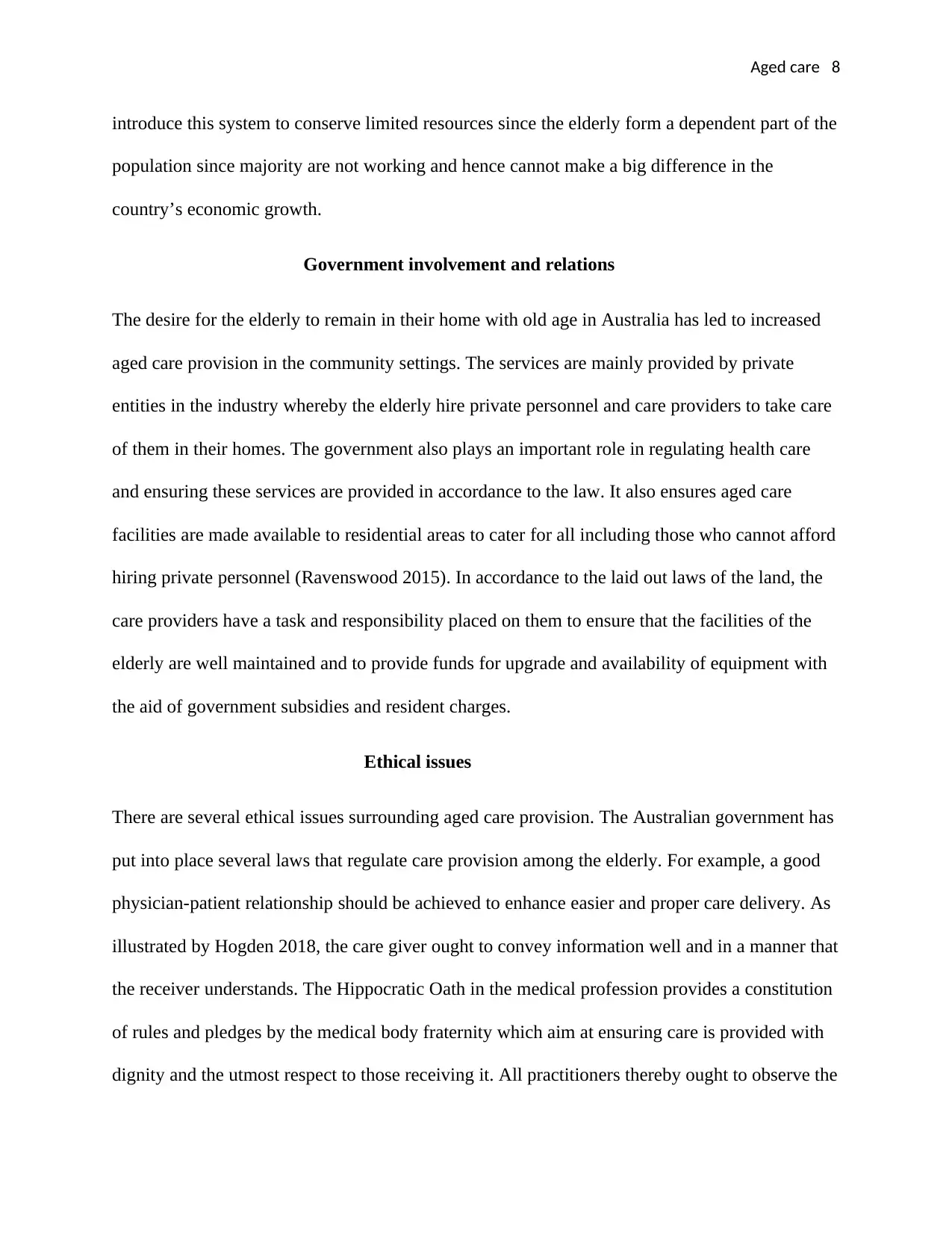
Aged care 8
introduce this system to conserve limited resources since the elderly form a dependent part of the
population since majority are not working and hence cannot make a big difference in the
country’s economic growth.
Government involvement and relations
The desire for the elderly to remain in their home with old age in Australia has led to increased
aged care provision in the community settings. The services are mainly provided by private
entities in the industry whereby the elderly hire private personnel and care providers to take care
of them in their homes. The government also plays an important role in regulating health care
and ensuring these services are provided in accordance to the law. It also ensures aged care
facilities are made available to residential areas to cater for all including those who cannot afford
hiring private personnel (Ravenswood 2015). In accordance to the laid out laws of the land, the
care providers have a task and responsibility placed on them to ensure that the facilities of the
elderly are well maintained and to provide funds for upgrade and availability of equipment with
the aid of government subsidies and resident charges.
Ethical issues
There are several ethical issues surrounding aged care provision. The Australian government has
put into place several laws that regulate care provision among the elderly. For example, a good
physician-patient relationship should be achieved to enhance easier and proper care delivery. As
illustrated by Hogden 2018, the care giver ought to convey information well and in a manner that
the receiver understands. The Hippocratic Oath in the medical profession provides a constitution
of rules and pledges by the medical body fraternity which aim at ensuring care is provided with
dignity and the utmost respect to those receiving it. All practitioners thereby ought to observe the
introduce this system to conserve limited resources since the elderly form a dependent part of the
population since majority are not working and hence cannot make a big difference in the
country’s economic growth.
Government involvement and relations
The desire for the elderly to remain in their home with old age in Australia has led to increased
aged care provision in the community settings. The services are mainly provided by private
entities in the industry whereby the elderly hire private personnel and care providers to take care
of them in their homes. The government also plays an important role in regulating health care
and ensuring these services are provided in accordance to the law. It also ensures aged care
facilities are made available to residential areas to cater for all including those who cannot afford
hiring private personnel (Ravenswood 2015). In accordance to the laid out laws of the land, the
care providers have a task and responsibility placed on them to ensure that the facilities of the
elderly are well maintained and to provide funds for upgrade and availability of equipment with
the aid of government subsidies and resident charges.
Ethical issues
There are several ethical issues surrounding aged care provision. The Australian government has
put into place several laws that regulate care provision among the elderly. For example, a good
physician-patient relationship should be achieved to enhance easier and proper care delivery. As
illustrated by Hogden 2018, the care giver ought to convey information well and in a manner that
the receiver understands. The Hippocratic Oath in the medical profession provides a constitution
of rules and pledges by the medical body fraternity which aim at ensuring care is provided with
dignity and the utmost respect to those receiving it. All practitioners thereby ought to observe the
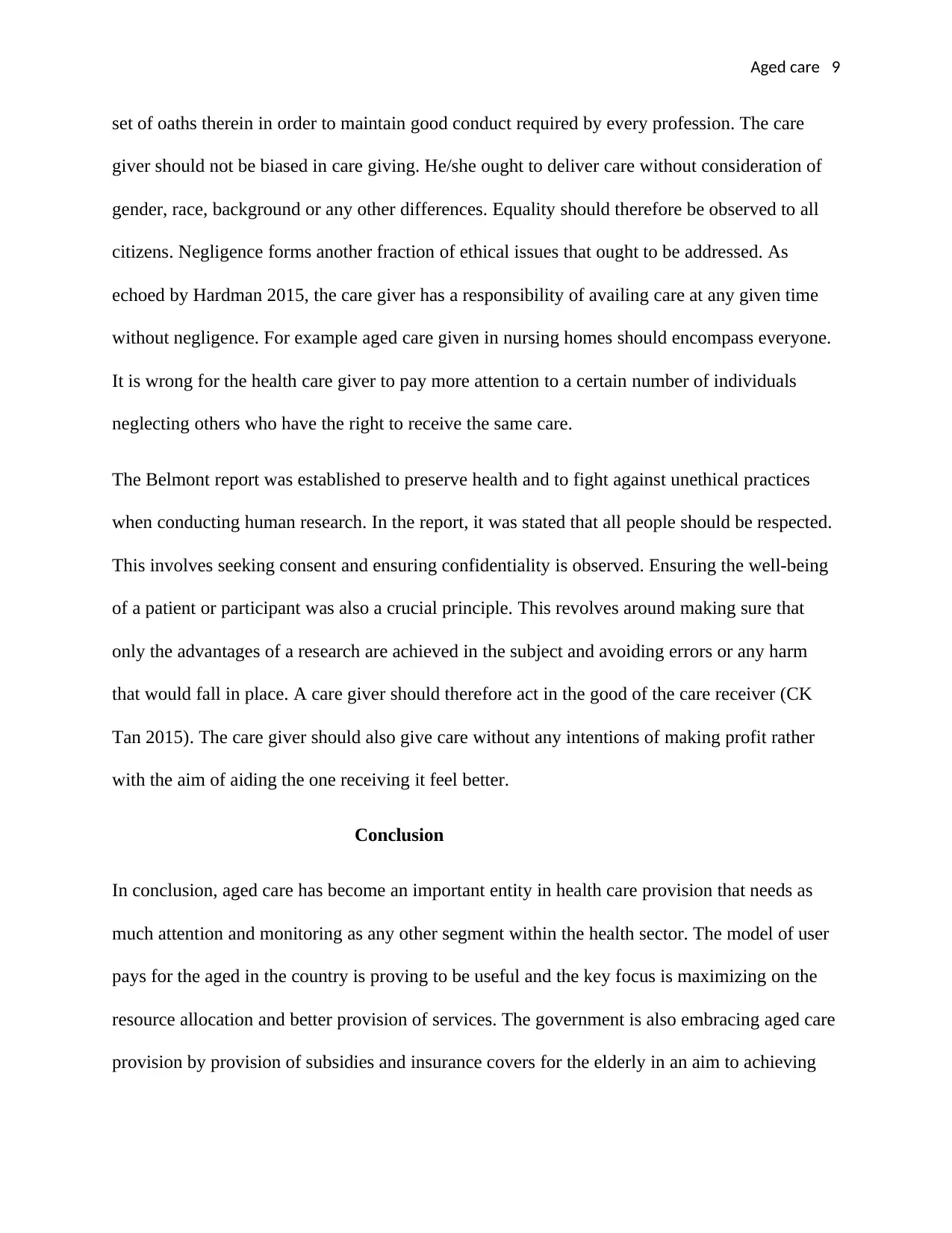
Aged care 9
set of oaths therein in order to maintain good conduct required by every profession. The care
giver should not be biased in care giving. He/she ought to deliver care without consideration of
gender, race, background or any other differences. Equality should therefore be observed to all
citizens. Negligence forms another fraction of ethical issues that ought to be addressed. As
echoed by Hardman 2015, the care giver has a responsibility of availing care at any given time
without negligence. For example aged care given in nursing homes should encompass everyone.
It is wrong for the health care giver to pay more attention to a certain number of individuals
neglecting others who have the right to receive the same care.
The Belmont report was established to preserve health and to fight against unethical practices
when conducting human research. In the report, it was stated that all people should be respected.
This involves seeking consent and ensuring confidentiality is observed. Ensuring the well-being
of a patient or participant was also a crucial principle. This revolves around making sure that
only the advantages of a research are achieved in the subject and avoiding errors or any harm
that would fall in place. A care giver should therefore act in the good of the care receiver (CK
Tan 2015). The care giver should also give care without any intentions of making profit rather
with the aim of aiding the one receiving it feel better.
Conclusion
In conclusion, aged care has become an important entity in health care provision that needs as
much attention and monitoring as any other segment within the health sector. The model of user
pays for the aged in the country is proving to be useful and the key focus is maximizing on the
resource allocation and better provision of services. The government is also embracing aged care
provision by provision of subsidies and insurance covers for the elderly in an aim to achieving
set of oaths therein in order to maintain good conduct required by every profession. The care
giver should not be biased in care giving. He/she ought to deliver care without consideration of
gender, race, background or any other differences. Equality should therefore be observed to all
citizens. Negligence forms another fraction of ethical issues that ought to be addressed. As
echoed by Hardman 2015, the care giver has a responsibility of availing care at any given time
without negligence. For example aged care given in nursing homes should encompass everyone.
It is wrong for the health care giver to pay more attention to a certain number of individuals
neglecting others who have the right to receive the same care.
The Belmont report was established to preserve health and to fight against unethical practices
when conducting human research. In the report, it was stated that all people should be respected.
This involves seeking consent and ensuring confidentiality is observed. Ensuring the well-being
of a patient or participant was also a crucial principle. This revolves around making sure that
only the advantages of a research are achieved in the subject and avoiding errors or any harm
that would fall in place. A care giver should therefore act in the good of the care receiver (CK
Tan 2015). The care giver should also give care without any intentions of making profit rather
with the aim of aiding the one receiving it feel better.
Conclusion
In conclusion, aged care has become an important entity in health care provision that needs as
much attention and monitoring as any other segment within the health sector. The model of user
pays for the aged in the country is proving to be useful and the key focus is maximizing on the
resource allocation and better provision of services. The government is also embracing aged care
provision by provision of subsidies and insurance covers for the elderly in an aim to achieving
⊘ This is a preview!⊘
Do you want full access?
Subscribe today to unlock all pages.

Trusted by 1+ million students worldwide
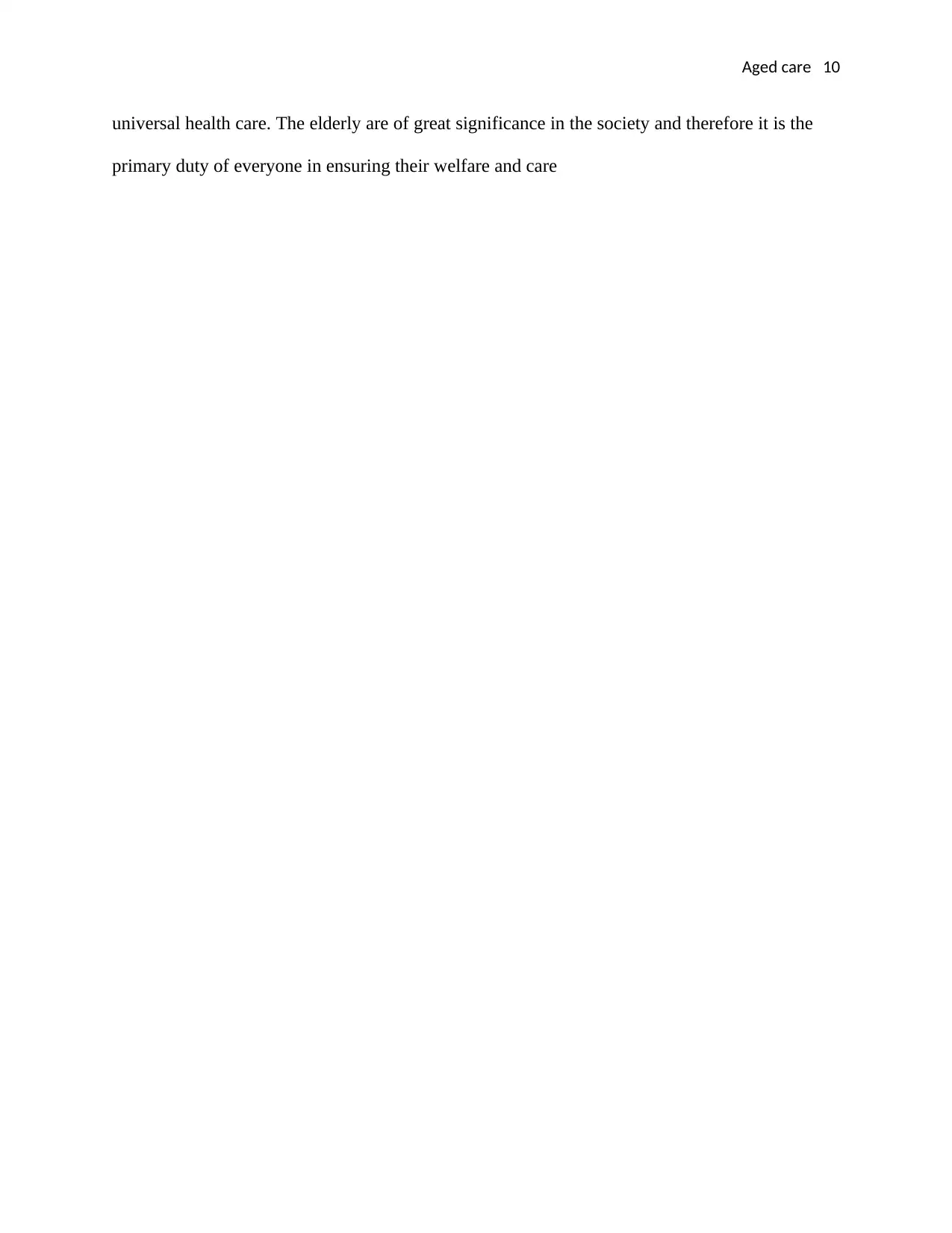
Aged care 10
universal health care. The elderly are of great significance in the society and therefore it is the
primary duty of everyone in ensuring their welfare and care
universal health care. The elderly are of great significance in the society and therefore it is the
primary duty of everyone in ensuring their welfare and care
Paraphrase This Document
Need a fresh take? Get an instant paraphrase of this document with our AI Paraphraser
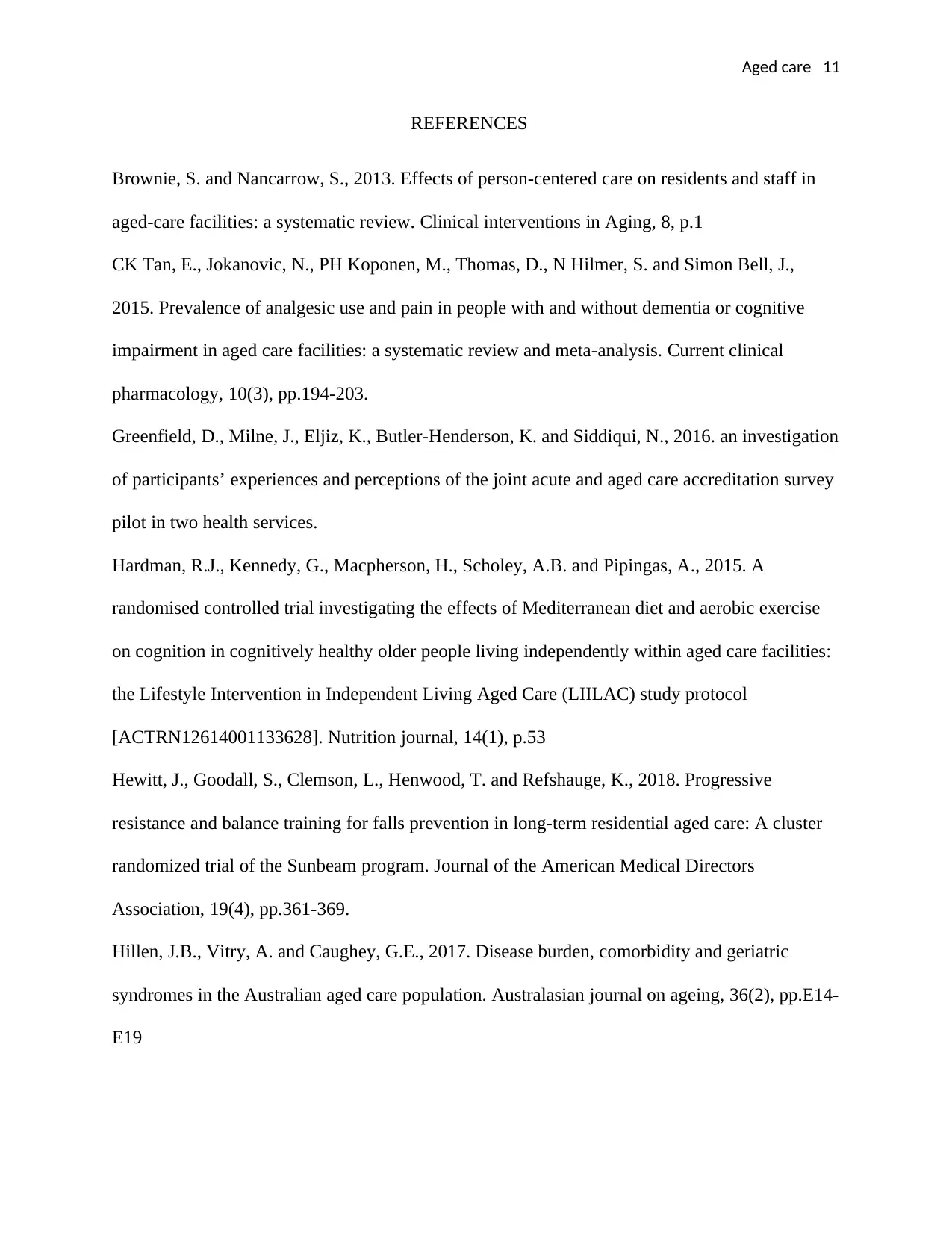
Aged care 11
REFERENCES
Brownie, S. and Nancarrow, S., 2013. Effects of person-centered care on residents and staff in
aged-care facilities: a systematic review. Clinical interventions in Aging, 8, p.1
CK Tan, E., Jokanovic, N., PH Koponen, M., Thomas, D., N Hilmer, S. and Simon Bell, J.,
2015. Prevalence of analgesic use and pain in people with and without dementia or cognitive
impairment in aged care facilities: a systematic review and meta-analysis. Current clinical
pharmacology, 10(3), pp.194-203.
Greenfield, D., Milne, J., Eljiz, K., Butler-Henderson, K. and Siddiqui, N., 2016. an investigation
of participants’ experiences and perceptions of the joint acute and aged care accreditation survey
pilot in two health services.
Hardman, R.J., Kennedy, G., Macpherson, H., Scholey, A.B. and Pipingas, A., 2015. A
randomised controlled trial investigating the effects of Mediterranean diet and aerobic exercise
on cognition in cognitively healthy older people living independently within aged care facilities:
the Lifestyle Intervention in Independent Living Aged Care (LIILAC) study protocol
[ACTRN12614001133628]. Nutrition journal, 14(1), p.53
Hewitt, J., Goodall, S., Clemson, L., Henwood, T. and Refshauge, K., 2018. Progressive
resistance and balance training for falls prevention in long-term residential aged care: A cluster
randomized trial of the Sunbeam program. Journal of the American Medical Directors
Association, 19(4), pp.361-369.
Hillen, J.B., Vitry, A. and Caughey, G.E., 2017. Disease burden, comorbidity and geriatric
syndromes in the Australian aged care population. Australasian journal on ageing, 36(2), pp.E14-
E19
REFERENCES
Brownie, S. and Nancarrow, S., 2013. Effects of person-centered care on residents and staff in
aged-care facilities: a systematic review. Clinical interventions in Aging, 8, p.1
CK Tan, E., Jokanovic, N., PH Koponen, M., Thomas, D., N Hilmer, S. and Simon Bell, J.,
2015. Prevalence of analgesic use and pain in people with and without dementia or cognitive
impairment in aged care facilities: a systematic review and meta-analysis. Current clinical
pharmacology, 10(3), pp.194-203.
Greenfield, D., Milne, J., Eljiz, K., Butler-Henderson, K. and Siddiqui, N., 2016. an investigation
of participants’ experiences and perceptions of the joint acute and aged care accreditation survey
pilot in two health services.
Hardman, R.J., Kennedy, G., Macpherson, H., Scholey, A.B. and Pipingas, A., 2015. A
randomised controlled trial investigating the effects of Mediterranean diet and aerobic exercise
on cognition in cognitively healthy older people living independently within aged care facilities:
the Lifestyle Intervention in Independent Living Aged Care (LIILAC) study protocol
[ACTRN12614001133628]. Nutrition journal, 14(1), p.53
Hewitt, J., Goodall, S., Clemson, L., Henwood, T. and Refshauge, K., 2018. Progressive
resistance and balance training for falls prevention in long-term residential aged care: A cluster
randomized trial of the Sunbeam program. Journal of the American Medical Directors
Association, 19(4), pp.361-369.
Hillen, J.B., Vitry, A. and Caughey, G.E., 2017. Disease burden, comorbidity and geriatric
syndromes in the Australian aged care population. Australasian journal on ageing, 36(2), pp.E14-
E19
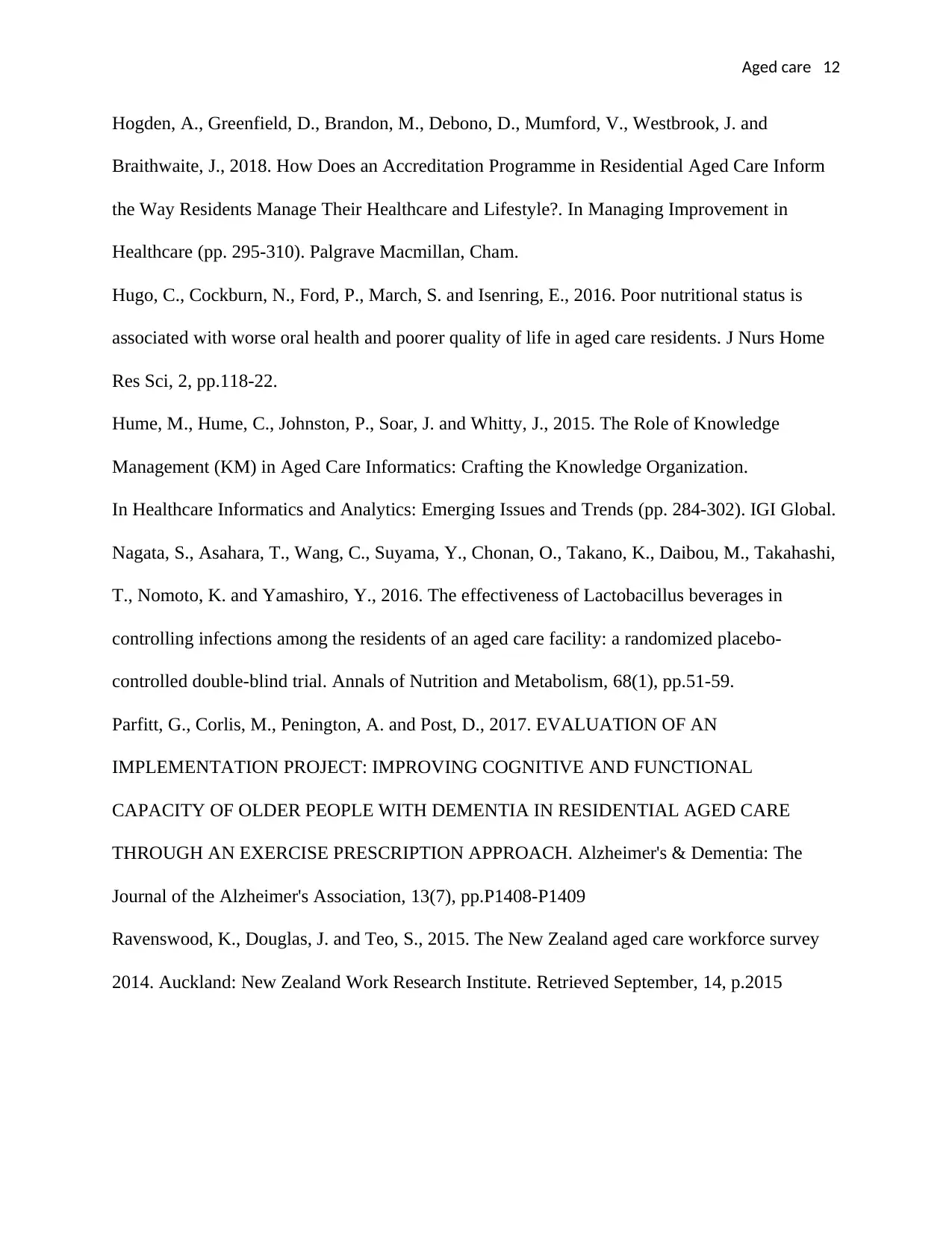
Aged care 12
Hogden, A., Greenfield, D., Brandon, M., Debono, D., Mumford, V., Westbrook, J. and
Braithwaite, J., 2018. How Does an Accreditation Programme in Residential Aged Care Inform
the Way Residents Manage Their Healthcare and Lifestyle?. In Managing Improvement in
Healthcare (pp. 295-310). Palgrave Macmillan, Cham.
Hugo, C., Cockburn, N., Ford, P., March, S. and Isenring, E., 2016. Poor nutritional status is
associated with worse oral health and poorer quality of life in aged care residents. J Nurs Home
Res Sci, 2, pp.118-22.
Hume, M., Hume, C., Johnston, P., Soar, J. and Whitty, J., 2015. The Role of Knowledge
Management (KM) in Aged Care Informatics: Crafting the Knowledge Organization.
In Healthcare Informatics and Analytics: Emerging Issues and Trends (pp. 284-302). IGI Global.
Nagata, S., Asahara, T., Wang, C., Suyama, Y., Chonan, O., Takano, K., Daibou, M., Takahashi,
T., Nomoto, K. and Yamashiro, Y., 2016. The effectiveness of Lactobacillus beverages in
controlling infections among the residents of an aged care facility: a randomized placebo-
controlled double-blind trial. Annals of Nutrition and Metabolism, 68(1), pp.51-59.
Parfitt, G., Corlis, M., Penington, A. and Post, D., 2017. EVALUATION OF AN
IMPLEMENTATION PROJECT: IMPROVING COGNITIVE AND FUNCTIONAL
CAPACITY OF OLDER PEOPLE WITH DEMENTIA IN RESIDENTIAL AGED CARE
THROUGH AN EXERCISE PRESCRIPTION APPROACH. Alzheimer's & Dementia: The
Journal of the Alzheimer's Association, 13(7), pp.P1408-P1409
Ravenswood, K., Douglas, J. and Teo, S., 2015. The New Zealand aged care workforce survey
2014. Auckland: New Zealand Work Research Institute. Retrieved September, 14, p.2015
Hogden, A., Greenfield, D., Brandon, M., Debono, D., Mumford, V., Westbrook, J. and
Braithwaite, J., 2018. How Does an Accreditation Programme in Residential Aged Care Inform
the Way Residents Manage Their Healthcare and Lifestyle?. In Managing Improvement in
Healthcare (pp. 295-310). Palgrave Macmillan, Cham.
Hugo, C., Cockburn, N., Ford, P., March, S. and Isenring, E., 2016. Poor nutritional status is
associated with worse oral health and poorer quality of life in aged care residents. J Nurs Home
Res Sci, 2, pp.118-22.
Hume, M., Hume, C., Johnston, P., Soar, J. and Whitty, J., 2015. The Role of Knowledge
Management (KM) in Aged Care Informatics: Crafting the Knowledge Organization.
In Healthcare Informatics and Analytics: Emerging Issues and Trends (pp. 284-302). IGI Global.
Nagata, S., Asahara, T., Wang, C., Suyama, Y., Chonan, O., Takano, K., Daibou, M., Takahashi,
T., Nomoto, K. and Yamashiro, Y., 2016. The effectiveness of Lactobacillus beverages in
controlling infections among the residents of an aged care facility: a randomized placebo-
controlled double-blind trial. Annals of Nutrition and Metabolism, 68(1), pp.51-59.
Parfitt, G., Corlis, M., Penington, A. and Post, D., 2017. EVALUATION OF AN
IMPLEMENTATION PROJECT: IMPROVING COGNITIVE AND FUNCTIONAL
CAPACITY OF OLDER PEOPLE WITH DEMENTIA IN RESIDENTIAL AGED CARE
THROUGH AN EXERCISE PRESCRIPTION APPROACH. Alzheimer's & Dementia: The
Journal of the Alzheimer's Association, 13(7), pp.P1408-P1409
Ravenswood, K., Douglas, J. and Teo, S., 2015. The New Zealand aged care workforce survey
2014. Auckland: New Zealand Work Research Institute. Retrieved September, 14, p.2015
⊘ This is a preview!⊘
Do you want full access?
Subscribe today to unlock all pages.

Trusted by 1+ million students worldwide
1 out of 13
Related Documents
Your All-in-One AI-Powered Toolkit for Academic Success.
+13062052269
info@desklib.com
Available 24*7 on WhatsApp / Email
![[object Object]](/_next/static/media/star-bottom.7253800d.svg)
Unlock your academic potential
Copyright © 2020–2025 A2Z Services. All Rights Reserved. Developed and managed by ZUCOL.




